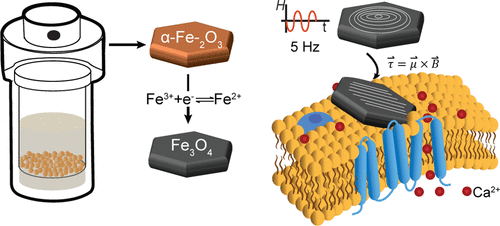Our official English website, www.x-mol.net, welcomes your feedback! (Note: you will need to create a separate account there.)
Magnetic Vortex Nanodiscs Enable Remote Magnetomechanical Neural Stimulation.
ACS Nano ( IF 17.1 ) Pub Date : 2020-06-19 , DOI: 10.1021/acsnano.0c00562 Danijela Gregurec 1, 2 , Alexander W Senko 1, 3 , Andrey Chuvilin 4, 5 , Pooja D Reddy 3 , Ashwin Sankararaman 1 , Dekel Rosenfeld 1, 2 , Po-Han Chiang 1, 2 , Francisco Garcia 2, 3 , Ian Tafel 6 , Georgios Varnavides 1, 3, 7 , Eugenia Ciocan 8 , Polina Anikeeva 1, 2, 3, 9
ACS Nano ( IF 17.1 ) Pub Date : 2020-06-19 , DOI: 10.1021/acsnano.0c00562 Danijela Gregurec 1, 2 , Alexander W Senko 1, 3 , Andrey Chuvilin 4, 5 , Pooja D Reddy 3 , Ashwin Sankararaman 1 , Dekel Rosenfeld 1, 2 , Po-Han Chiang 1, 2 , Francisco Garcia 2, 3 , Ian Tafel 6 , Georgios Varnavides 1, 3, 7 , Eugenia Ciocan 8 , Polina Anikeeva 1, 2, 3, 9
Affiliation

|
Magnetic nanomaterials in magnetic fields can serve as versatile transducers for remote interrogation of cell functions. In this study, we leveraged the transition from vortex to in-plane magnetization in iron oxide nanodiscs to modulate the activity of mechanosensory cells. When a vortex configuration of spins is present in magnetic nanomaterials, it enables rapid control over their magnetization direction and magnitude. The vortex configuration manifests in near zero net magnetic moment in the absence of a magnetic field, affording greater colloidal stability of magnetic nanomaterials in suspensions. Together, these properties invite the application of magnetic vortex particles as transducers of externally applied minimally invasive magnetic stimuli in biological systems. Using magnetic modeling and electron holography, we predict and experimentally demonstrate magnetic vortex states in an array of colloidally synthesized magnetite nanodiscs 98–226 nm in diameter. The magnetic nanodiscs applied as transducers of torque for remote control of mechanosensory neurons demonstrated the ability to trigger Ca2+ influx in weak (≤28 mT), slowly varying (≤5 Hz) magnetic fields. The extent of cellular response was determined by the magnetic nanodisc volume and magnetic field conditions. Magnetomechanical activation of a mechanosensitive cation channel TRPV4 (transient receptor potential vanilloid family member 4) exogenously expressed in the nonmechanosensitive HEK293 cells corroborated that the stimulation is mediated by mechanosensitive ion channels. With their large magnetic torques and colloidal stability, magnetic vortex particles may facilitate basic studies of mechanoreception and its applications to control electroactive cells with remote magnetic stimuli.
中文翻译:

磁性涡流纳米圆盘可实现远程磁机械神经刺激。
磁场中的磁性纳米材料可用作远程询问细胞功能的多功能传感器。在这项研究中,我们利用氧化铁纳米盘中从涡旋到面内磁化的转变来调节机械感觉细胞的活动。当磁性纳米材料中存在自旋的涡旋配置时,它可以快速控制其磁化方向和大小。在没有磁场的情况下,涡旋结构表现为近零净磁矩,从而使悬浮液中的磁性纳米材料具有更大的胶体稳定性。总之,这些特性促使磁涡流粒子作为生物系统中外部施加的微创磁刺激的换能器的应用。使用磁建模和电子全息,我们预测并通过实验证明了一系列直径为 98-226 nm 的胶体合成磁铁矿纳米盘中的磁涡流状态。用作远程控制机械感觉神经元的扭矩传感器的磁性纳米圆盘证明了触发 Ca 的能力2+流入弱 (≤28 mT)、缓慢变化 (≤5 Hz) 的磁场。细胞反应的程度由磁性纳米圆盘体积和磁场条件决定。在非机械敏感的 HEK293 细胞中外源性表达的机械敏感阳离子通道 TRPV4(瞬态受体电位香草家族成员 4)的磁机械激活证实了刺激是由机械敏感离子通道介导的。凭借其大磁扭矩和胶体稳定性,磁性涡旋粒子可以促进机械感受的基础研究及其在远程磁刺激下控制电活性细胞的应用。
更新日期:2020-07-28
中文翻译:

磁性涡流纳米圆盘可实现远程磁机械神经刺激。
磁场中的磁性纳米材料可用作远程询问细胞功能的多功能传感器。在这项研究中,我们利用氧化铁纳米盘中从涡旋到面内磁化的转变来调节机械感觉细胞的活动。当磁性纳米材料中存在自旋的涡旋配置时,它可以快速控制其磁化方向和大小。在没有磁场的情况下,涡旋结构表现为近零净磁矩,从而使悬浮液中的磁性纳米材料具有更大的胶体稳定性。总之,这些特性促使磁涡流粒子作为生物系统中外部施加的微创磁刺激的换能器的应用。使用磁建模和电子全息,我们预测并通过实验证明了一系列直径为 98-226 nm 的胶体合成磁铁矿纳米盘中的磁涡流状态。用作远程控制机械感觉神经元的扭矩传感器的磁性纳米圆盘证明了触发 Ca 的能力2+流入弱 (≤28 mT)、缓慢变化 (≤5 Hz) 的磁场。细胞反应的程度由磁性纳米圆盘体积和磁场条件决定。在非机械敏感的 HEK293 细胞中外源性表达的机械敏感阳离子通道 TRPV4(瞬态受体电位香草家族成员 4)的磁机械激活证实了刺激是由机械敏感离子通道介导的。凭借其大磁扭矩和胶体稳定性,磁性涡旋粒子可以促进机械感受的基础研究及其在远程磁刺激下控制电活性细胞的应用。



























 京公网安备 11010802027423号
京公网安备 11010802027423号